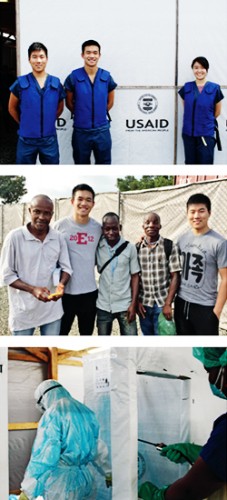Jason Kang | Biomedical Engineering | Senior
 Increasing groundwater extraction from the deep aquifers in the US is leading to a significant decline of groundwater stocks that are used to buffer droughts. Upmanu Lall and his group are working on solutions for overall water management that can reverse this trend. (Image courtesy of Columbia Water Center)
Increasing groundwater extraction from the deep aquifers in the US is leading to a significant decline of groundwater stocks that are used to buffer droughts. Upmanu Lall and his group are working on solutions for overall water management that can reverse this trend. (Image courtesy of Columbia Water Center)
Jason Kang’s father provided him with some crucial advice: “The most powerful lesson my dad taught me about inventing is that the problem is infinitely more important than the solution.” For Kang, this principle proved to be formative. As a teenager doing research in the lab of his father (an associate professor at Harvard Medical School and director of its Laboratory for Lipid Medicine and Technology), he grew fascinated with the ability to discover knowledge with potential to solve the world’s problems. It wasn’t until Kang arrived at Columbia, however, that he connected his passion for problem solving with engineering. “What I love about engineering is that it’s all about applications—taking the knowledge that people have discovered from research and making it into something useful to improve the lives of others.”
Kang, a senior studying biomedical engineering, continues to find himself inspired by SEAS. “Columbia Engineering is always working to get better. Mudd got renovated with the Makerspace, Dean [Mary C.] Boyce started design challenges, and entrepreneurship is getting more and more funding. It’s really a place where innovation can thrive.”
In October 2014, Kang attended the Ebola Design Challenge where discussion centered around urgent issues in need of solutions. “One of the biggest problems they mentioned that first day was that there was no way to guarantee complete coverage since bleach, which they use for disinfection, is transparent. As a result, a shocking number of health care workers were being infected and dying.” Kang, along with friends Katherine Jin ’16CC and Kevin Tyan, ’16CC came up with the idea to colorize disinfectant to provide better coverage. The three cofounded Kinnos Inc. and devoted months of hard work to perfecting Highlight, a product for which they won the USAID Fighting Ebola Grand Challenge and received national attention in making the list of Forbes 30 Under 30 in Healthcare.
 An engineered green roof in
An engineered green roof in
New York City
(Photo by Daniel Marasco)
For Kang, however, the most thrilling aspect of the project hasn’t come from accolades but from seeing the impact. “The thing that’s resonated most with me was field-testing Highlight with health care workers in Liberia. They are some of the most inspiring and courageous people I’ve ever met. To know that I’m working on something that will protect them from infection, to give them confidence in their safety and make their lives even a little bit easier, makes it all that much more worth it.”
As for his downtime, Kang loves to unwind by cooking. And if he is not creating his own delicious food, he loves exploring New York City to find it. “You can get these unbelievably fresh lamb dumplings at Golden Shopping Mall in Flushing, and I could eat Cemita’s fried chicken sandwiches at Smorgasburg for the rest of my life.” He also cites another highlight of a much-decorated Columbia tenure. “Above and beyond everything that’s happened in college, the most important thing I’ll take away from all of this are my friends.”
Kang already has amassed quite a resume, including becoming the vice president of engineering for Jibon Health Technologies before even graduating, and his future promises to be equally bright. Kang and his cofounders plan to continue with Kinnos full time. Their hope is to have Highlight widely distributed, as they continue to explore more problems in need of solutions. “For me,” he says, with characteristic altruism, “my measure of success is the number of people I’ve been able to help.” A number that is likely on
